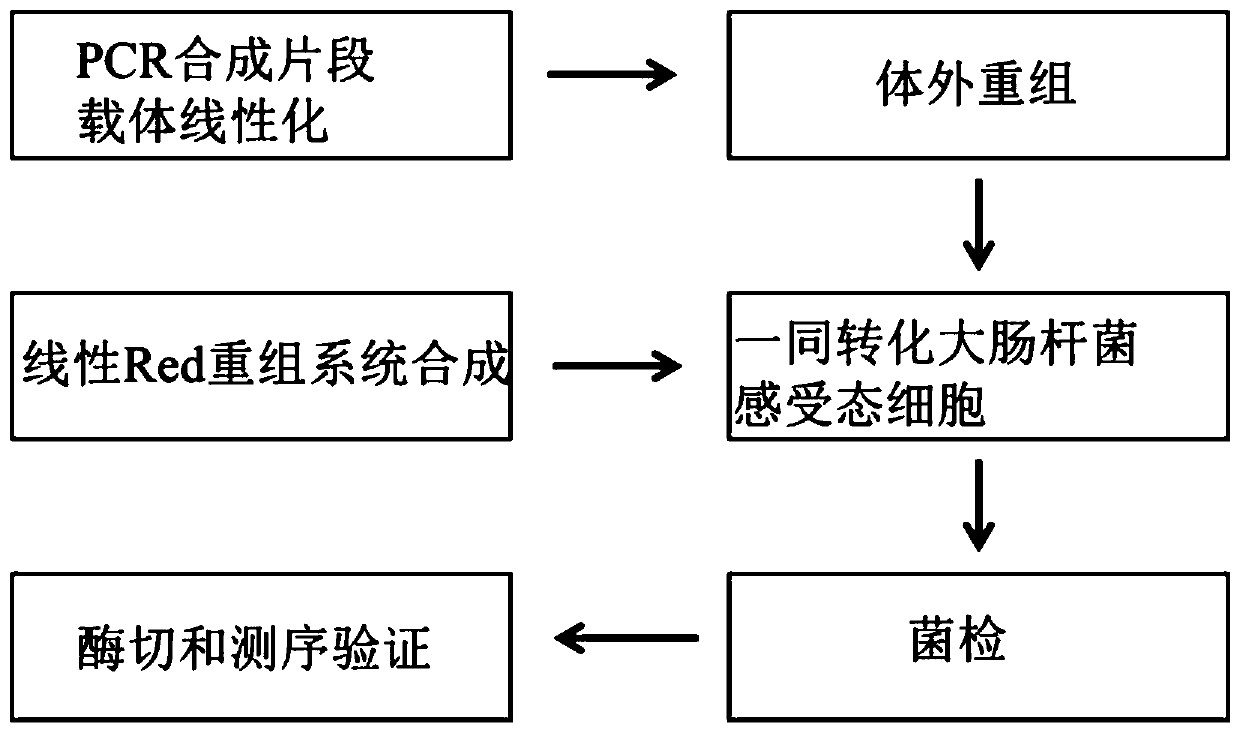Super-large plasmid construction kit, super-large plasmid construction method and application thereof
A kit and plasmid technology, applied in the field of synthetic biology, can solve the problems of weak assembly ability of large fragments of DNA, difficult in vivo assembly of super-large plasmids, and low assembly success rate, so as to enhance in vivo assembly ability, improve in vivo recombination efficiency, and improve The effect of the synthesis success rate
- Summary
- Abstract
- Description
- Claims
- Application Information
AI Technical Summary
Problems solved by technology
Method used
Image
Examples
Embodiment 1
[0070] The in vitro assembly of embodiment 1 ultra-large plasmid
[0071] The construction process of super large plasmids is as follows: figure 1 As shown, in this example, the in vitro assembly of the ultra-large plasmid was first carried out.
[0072] (1) Splitting of large fragments of DNA
[0073] Sequence analysis software was used to analyze the 32kb large fragment DNA, split into four fragments of 8kb in length, and then continue to split the 8kb fragment into 2kb initial fragments, and design homology arms between adjacent initial fragments ( The homology arm is the leftmost 60bp sequence and the rightmost 60bp sequence of the initial fragment) for subsequent homologous recombination;
[0074] (2) Splitting of the initial segment
[0075] Use sequence analysis software to split the initial fragments into DNA fragments to be assembled F n , n=30, F n It is a long primer sequence separated by forward and reverse directions, and the adjacent fragment contains a 20bp...
Embodiment 2
[0091] Example 2 Preparation of linearized lambda phage Red recombination system
[0092] The λ bacteriophage Red recombination system (SEQ ID NO: 1) was digested, and the system is shown in Table 5, and the linearized enzyme digestion product was recovered and purified to obtain the linearized λ phage Red recombination system.
[0093] SEQ ID NO: 1:
[0094]aagaaaccaattgtccatattgcatcagacattgccgtcactgcgtcttttactggctcttctcgctaaccaaaccggtaaccccgcttattaaaagcattctgtaacaaagcgggaccaaagccatgacaaaaacgcgtaacaaaagtgtctataatcacggcagaaaagtccacattgattatttgcacggcgtcacactttgctatgccatagcatttttatccataagattagcggatcctacctgacgctttttatcgcaactctctactgtttctccatacccgtttttttgggaattcgagctctaaggaggttataaaaaatggatattaatactgaaactgagatcaagcaaaagcattcactaaccccctttcctgttttcctaatcagcccggcatttcgcgggcgatattttcacagctatttcaggagttcagccatgaacgcttattacattcaggatcgtcttgaggctcagagctgggcgcgtcactaccagcagctcgcccgtgaagagaaagaggcagaactggcagacgacatggaaaaaggcctgccccagcacctgtttgaatcgctatgcatcgatcatttgcaacgccacggggccagcaaaaaatcc...
Embodiment 3
[0097] Example 3 Preparation of Escherichia coli Electrotransfer Competent Cells
[0098] (1) Pick fresh EPI300 colonies and inoculate them into 4 mL of LB medium, and culture overnight at 37°C under a well-ventilated condition;
[0099] (2) Dilute 1 mL of overnight cultured cells into 300 mL of LB medium, and culture at 37°C for 2-3 hours in a well-ventilated condition until the OD600 is 0.5;
[0100] (3) Collect cells by centrifugation at 3,500rpm for 10min;
[0101] (4) Wash the cells twice with ice-cold sterile washing buffer, and centrifuge at 3,500 rpm for 10 min;
[0102] (5) The cell suspension was centrifuged at 3,500 rpm for 10 minutes, and the supernatant was poured out immediately after the centrifugation;
[0103] (6) Wash the cells twice with a solution containing 10% ultrapure glycerol and 90% ultrapure double distilled water, and centrifuge at 4,000 rpm for 10 min;
[0104] (7) Resuspend the cells in washing buffer (approximately 2 mL), aliquot and freeze at...
PUM
 Login to View More
Login to View More Abstract
Description
Claims
Application Information
 Login to View More
Login to View More - R&D
- Intellectual Property
- Life Sciences
- Materials
- Tech Scout
- Unparalleled Data Quality
- Higher Quality Content
- 60% Fewer Hallucinations
Browse by: Latest US Patents, China's latest patents, Technical Efficacy Thesaurus, Application Domain, Technology Topic, Popular Technical Reports.
© 2025 PatSnap. All rights reserved.Legal|Privacy policy|Modern Slavery Act Transparency Statement|Sitemap|About US| Contact US: help@patsnap.com



